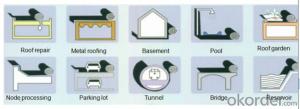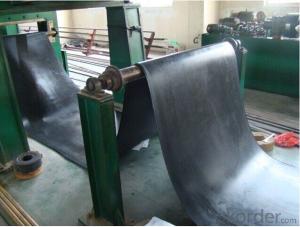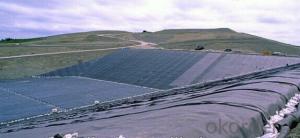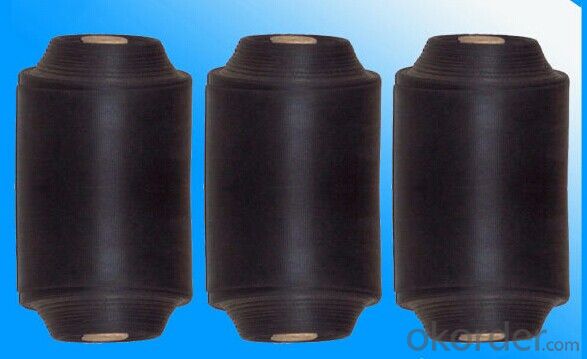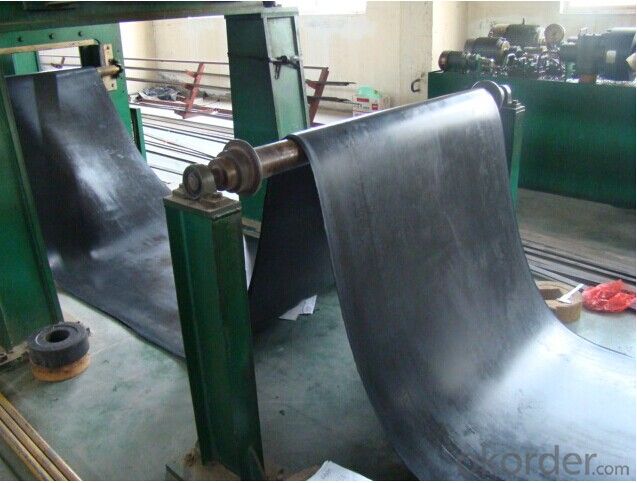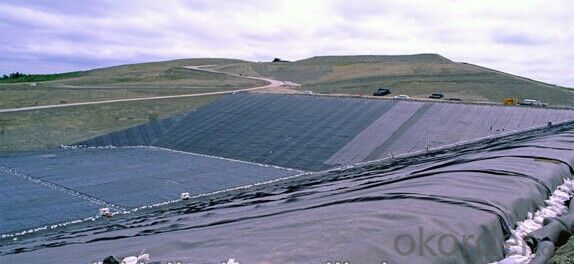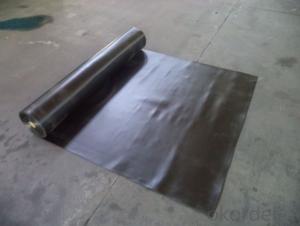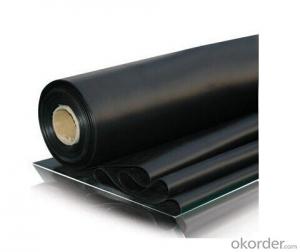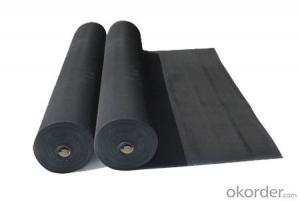EPDM Valcanized Waterproof Membrane with width 1.2mm
- Loading Port:
- Qingdao
- Payment Terms:
- TT OR LC
- Min Order Qty:
- 2000 m²
- Supply Capability:
- 300000 m²/month
OKorder Service Pledge
OKorder Financial Service
You Might Also Like
EPDM Waterproof Membrane
Introduction for EPDM Waterproof Membrane
EPDM waterproof membrane is made from ternary ethylene-propylene rubber. With the best performance among high polymer waterproof materials, EPDM is of exceptional elasticity and will not split or crack under normal building movement.
Features for EPDM Waterproof Membrane
1. Waterproofing EPDM roof membrane has excellent resistance to environmental stress cracking resistance, aging resistance, corrosion resistance as well as long service life.
2.Waterproofing EPDM roof membrane has the lowest permeability
3. Waterproofing EPDM roof membrane has high elongation,heat treatment the size change is small
Main Function for EPDM Waterproof Membrane
1. EPDM waterproof membrane for bridge engineering waterproof
2. EPDM waterproof membrane for water conservancy projects ,such as river bank,lake dam seepage.
3.EPDM waterproof membrane for the municipal engineering.
4. EPDM waterproof membrane for aquaculture.
Specification for EPDM Waterproof Membrane
Item | Thick(mm) | Width | Length(m) | Color |
Spe | 1.0—2.0 | 1.2m/2m/3m/4m | 20 | Black |
Deviation | -1 +15 | --1 | Multicolor |
Technical Sheet for EPDM Waterproof Membrane
EPDM Waterproof Membrane ASTM Standard : D-7465 | ||||
Property | Test Method | Units | Mininum ASTM | |
D-7465 | ||||
Sl | Eng | |||
Specific Gravity | ASTM D-792 | gm/cc | 1.1 | 1.1 |
Unit Weight | ASTM D-751 | kg/m2 | 1.3 | 0.27 |
Thickness Type 1 | ASTM D-412 | mm(in) | 1.02 | 0.04 |
Tensile Strength. Die C | ASTM D-412 | Mpa(psi) | 9 | 1305 |
Ultimate Elongation,Die C | ASTM D-412 | % | 300 | 300 |
Tear Resistance,Die C | ASTM D-624 | Kn/m(lbf/in) | 26.27 | 150 |
Puncture Resistance | ASTM D-4833 | N(lbs) | 133 | 30 |
Shore A Durometer | ASTM D-2240 | 65-10 | 65-10 | |
Ozone Resistance | ASTM D-1149 | No Crack | No Crack | |
Multiaxial Elongation | ASTM D-5617 | % | 100 | 100 |
Heat Aging 28 days at 240 degrees | ASTM D-573 | |||
Tensile Strength, Die C | ASTM D-412 | MPa(psi) | 8.3 | 1205 |
Ultimate elongation, Die C | ASTM D-412 | % | 200 | 200 |
Tear Resistance, Die C | ASTM-624 | Kn/m(lbf/in) | 21.9 | 125 |
Accelerated Aging Xenon Arc | ASTM G-155/G-151 | Pass | Pass | |
Brittleness Point | ASTM D-2137 | -45 °C | -49 °C F | |
Water Absorption | ASTM D-471 | % | +8,-2 | +8,-2 |
Water Vapor Permeability, max | ASTM E-96 | Permils | 2.0 | 2.0 |
Linear Dimensional Change,max | ASTM-D-1204 | % | +/-1.0 | +/-1.0 |
Chronic Toxicity Screening | EPA/600/4-89/001 | Method 1000.0 | Pass | Pass |
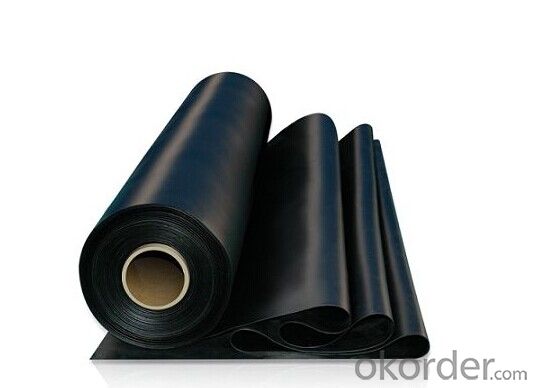

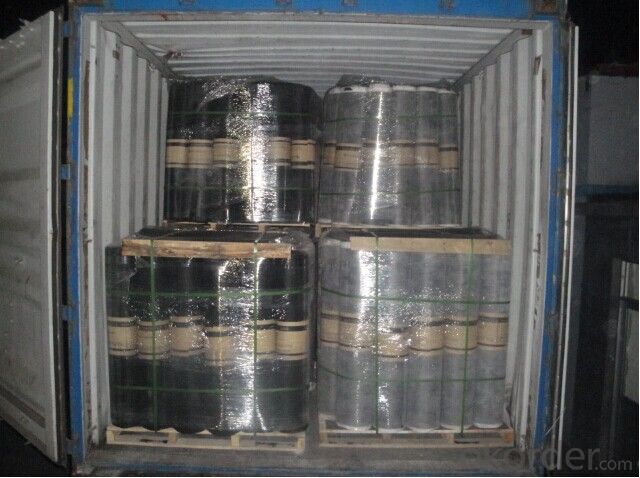
FAQ:
Can you produce 4m width?
Yes, no problem for us. We have four bases in China, largest one in this field.
How many quantity in one 20'' container for 1.2mm and 1.5mm?
480rolls, 11520m2 for 1.2mm and 400rolls, 9600m2 for 1.5mm
Can you provide free samples?
Yes, our samples are free, but express fees usually on buyer's account.
- Q: Does a waterproofing membrane provide any insulating properties?
- No, a waterproofing membrane does not provide any insulating properties. Its primary function is to prevent water penetration and protect the underlying structure from moisture damage.
- Q: Do you know how many square meters of waterproofing membrane to send a set of tests?
- PVC waterproofing membrane: take a roll at the end of 0.3m at the end of the interception of 3m full-width coil sample 2, 2000 square meters for a group, the lack of a group also. Polymer waterproofing membrane: 5000 ㎡ sheet for a group.
- Q: Can a waterproofing membrane be used on precast steel surfaces?
- Indeed, precast steel surfaces can benefit from the utilization of a waterproofing membrane. These membranes are specifically engineered to serve as a safeguard against water infiltration, making them suitable for various surfaces, including precast steel. By acting as a waterproof shield, the membrane effectively blocks water from penetrating the surface and causing any potential harm. It is imperative to ensure that the surface is adequately primed and sanitized prior to applying the membrane to ensure optimal adhesion and efficacy. Furthermore, seeking advice from a qualified waterproofing contractor is highly recommended in order to identify the most suitable membrane type and application technique for the specific precast steel surface.
- Q: Can a waterproofing membrane be used for storage tanks or containment areas?
- Storage tanks or containment areas can utilize a waterproofing membrane to prevent water or liquid penetration. These membranes serve as a barrier against such infiltrations and are therefore ideal for containment purposes. Rubber, PVC, or bitumen are commonly used materials for these membranes due to their water-resistant properties. They can be applied either internally or externally to storage tanks or containment areas to safeguard against leaks and moisture-related deterioration. Moreover, the use of waterproofing membranes aids in preventing the development of mold or mildew, thereby ensuring a secure and hygienic environment for stored materials or liquids.
- Q: Can a waterproofing membrane be used on below-grade walls?
- Yes, a waterproofing membrane can be used on below-grade walls. In fact, it is highly recommended to use a waterproofing membrane on below-grade walls to protect them from water infiltration and moisture damage. Below-grade walls are particularly vulnerable to water penetration due to their proximity to the ground and potential for hydrostatic pressure. A waterproofing membrane acts as a barrier, preventing water from seeping into the walls and causing issues such as mold, mildew, rot, and structural damage. It helps to keep the interior of the building dry, preventing potential moisture-related problems.
- Q: Can a waterproofing membrane be used for a bridge?
- A bridge can indeed utilize a waterproofing membrane. This specialized material is employed specifically to hinder the infiltration of water into structures, including bridges. Its application is typically on the surface of the bridge deck, creating an uninterrupted barrier against water penetration. This barrier is particularly crucial for bridges, as they are constantly exposed to environmental elements such as rain, snow, and moisture. The waterproofing membrane serves to safeguard the bridge deck and the concrete beneath it by preventing moisture damage, which can lead to deterioration and structural problems over time. With water penetration prevented, the lifespan of the bridge is extended, reducing the need for expensive repairs. Furthermore, the waterproofing membrane also enhances the bridge's overall durability and performance by minimizing the potential for reinforcing steel corrosion and blocking the entry of harmful chemicals. All in all, using a waterproofing membrane is highly recommended for bridges to ensure their long-term functionality and structural soundness.
- Q: What is the difference between a self-adhesive and torch-applied waterproofing membrane?
- A self-adhesive waterproofing membrane is a type of membrane that has an adhesive backing, allowing it to be easily stuck onto the surface it is being applied to. It is typically made of a flexible material, such as modified bitumen or rubberized asphalt, and is commonly used for applications such as roofs, balconies, or foundations. The adhesive backing ensures a strong and secure bond, even in challenging weather conditions. On the other hand, a torch-applied waterproofing membrane requires the use of a torch or heat gun to melt the underside of the membrane and adhere it to the surface. This type of membrane is often made of modified bitumen, which softens and becomes adhesive when heated. The heat creates a strong bond between the membrane and the substrate, providing excellent waterproofing protection. The main difference between these two types of waterproofing membranes lies in the way they are installed. Self-adhesive membranes offer a simpler and quicker installation process, as they can be directly applied to the surface without the need for any additional tools or equipment. They are also considered to be a safer option, as they eliminate the potential hazards associated with using an open flame. Torch-applied membranes, on the other hand, require the use of a torch or heat gun, which adds an extra step to the installation process. This method requires skilled labor and proper training to ensure the membrane is correctly melted and adhered to the surface. However, torch-applied membranes are often preferred in situations where a superior bond is required, such as on roofs with a steep slope or in areas with heavy foot traffic. In summary, the main difference between self-adhesive and torch-applied waterproofing membranes lies in the method of installation. Self-adhesive membranes offer simplicity and safety, while torch-applied membranes provide a stronger bond and are often used in more challenging or specific applications. The choice between the two ultimately depends on the specific requirements and conditions of the project.
- Q: Is a waterproofing membrane resistant to saltwater or other corrosive substances?
- Waterproofing membranes, in general, have the ability to resist saltwater and other substances that cause corrosion. These membranes are created to act as a barrier against moisture and water intrusion, offering protection against corrosive agents. The materials commonly used to manufacture these membranes, such as modified bitumen, PVC, EPDM, or TPO, naturally possess resistance to saltwater and other corrosive elements. Some manufacturers may even add extra layers or coatings to further enhance the membrane's ability to resist corrosive substances. Nevertheless, it is important to consider that the degree of resistance can vary depending on the specific type and quality of the waterproofing membrane employed. Therefore, it is crucial to select a high-quality membrane that is specifically designed for the intended application, whether it be in saltwater environments or areas exposed to other corrosive substances.
- Q: Can a waterproofing membrane be used for water tanks?
- Yes, a waterproofing membrane can be used for water tanks. Waterproofing membranes are specifically designed to prevent the passage of water and can effectively seal water tanks, ensuring that they remain watertight. These membranes are commonly made from materials such as bitumen, PVC, or EPDM, which provide excellent resistance to water and are capable of withstanding the harsh conditions often found in water tanks. Additionally, waterproofing membranes can be applied to various surfaces, including concrete, metal, and masonry, making them versatile and suitable for different types of water tanks. Overall, using a waterproofing membrane is a reliable solution for ensuring the integrity and longevity of water tanks by preventing water leakage and protecting the surrounding environment from potential water damage.
- Q: Is a waterproofing membrane resistant to mold and mildew growth?
- Indeed, the resistance of a waterproofing membrane to the growth of mold and mildew stems from its specific design, which aims to establish a barrier against moisture infiltration. This impedes water seepage and the subsequent development of mold and mildew. Through the effective sealing of the area, these membranes eradicate the favorable conditions for the proliferation of mold and mildew, such as dampness and moisture. However, it is important to acknowledge that although the membrane itself exhibits resistance to mold and mildew growth, it does not guarantee absolute protection against these issues. Proper installation, regular maintenance, and ensuring adequate ventilation play pivotal roles in preventing the long-term growth of mold and mildew.
Send your message to us
EPDM Valcanized Waterproof Membrane with width 1.2mm
- Loading Port:
- Qingdao
- Payment Terms:
- TT OR LC
- Min Order Qty:
- 2000 m²
- Supply Capability:
- 300000 m²/month
OKorder Service Pledge
OKorder Financial Service
Similar products
Hot products
Hot Searches
Related keywords
